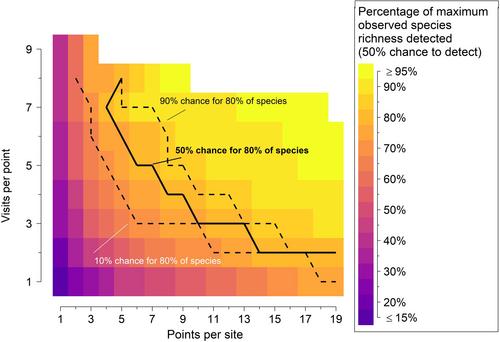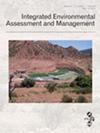下载PDF
{"title":"印第安纳州低地森林恢复点的调查工作和目标陆鸟群落指标","authors":"Benjamin M. West, Mark L. Wildhaber, Nicholas S. Green, John P. Isanhart, M. Victoria McDonald, Michael J. Hooper","doi":"10.1002/ieam.4992","DOIUrl":null,"url":null,"abstract":"<p>Many sampling and analytical methods can estimate the abundance, distributions, and diversity of birds and other wildlife. However, challenges with sample size and analytical capacity can make these methods difficult to implement for resource-limited monitoring programs. To apprise efficient and attainable sampling designs for landbird monitoring programs with limited observational data, we used breeding season bird point survey data collected in 2016 at four forest restoration sites in Indiana, USA. We evaluated three subsets of observed species richness, total possibly breeding landbirds, Partners in Flight Regional Conservation Concern (PIF RCC) landbirds, and interior forest specialists (IFSs). Simulated surveys based on field data were used to conduct Bayesian Michaelis–Menten curve analyses estimating observed species as a function of sampling effort. On comparing simulated survey sets with multiple habitat types versus those with one habitat, we found that those with multiple habitat types had estimated 39%–83% greater observed PIF RCC species richness and required 41%–55% fewer visits per point to observe an equivalent proportion of PIF RCC species. Even with multiple habitats in a survey set, the number of visits per point required to detect 50% of observable species was 30% higher for PIF RCC species than for total breeding landbird species. Low detection rates of IFS species at two field sites made precise estimation of required effort to observe these species difficult. However, qualitatively, we found that only sites containing mature forest fragments had detections of several bird species designated as high-confidence IFS species. Our results suggest that deriving specialized species diversity metrics from point survey data can add value when interpreting those data. Additionally, designing studies to collect these metrics may require explicitly planning to visit multiple habitat types at a monitoring site and increasing the number of visits per survey point. <i>Integr Environ Assess Manag</i> 2024;20:1954–1968. © 2024 The Author(s). <i>Integrated Environmental Assessment and Management</i> published by Wiley Periodicals LLC on behalf of Society of Environmental Toxicology & Chemistry (SETAC). This article has been contributed to by U.S. Government employees and their work is in the public domain in the USA.</p>","PeriodicalId":13557,"journal":{"name":"Integrated Environmental Assessment and Management","volume":"20 6","pages":"1954-1968"},"PeriodicalIF":3.0000,"publicationDate":"2024-09-18","publicationTypes":"Journal Article","fieldsOfStudy":null,"isOpenAccess":false,"openAccessPdf":"https://onlinelibrary.wiley.com/doi/epdf/10.1002/ieam.4992","citationCount":"0","resultStr":"{\"title\":\"Survey effort and targeted landbird community metrics at Indiana lowland forest restoration sites\",\"authors\":\"Benjamin M. West, Mark L. Wildhaber, Nicholas S. Green, John P. Isanhart, M. Victoria McDonald, Michael J. Hooper\",\"doi\":\"10.1002/ieam.4992\",\"DOIUrl\":null,\"url\":null,\"abstract\":\"<p>Many sampling and analytical methods can estimate the abundance, distributions, and diversity of birds and other wildlife. However, challenges with sample size and analytical capacity can make these methods difficult to implement for resource-limited monitoring programs. To apprise efficient and attainable sampling designs for landbird monitoring programs with limited observational data, we used breeding season bird point survey data collected in 2016 at four forest restoration sites in Indiana, USA. We evaluated three subsets of observed species richness, total possibly breeding landbirds, Partners in Flight Regional Conservation Concern (PIF RCC) landbirds, and interior forest specialists (IFSs). Simulated surveys based on field data were used to conduct Bayesian Michaelis–Menten curve analyses estimating observed species as a function of sampling effort. On comparing simulated survey sets with multiple habitat types versus those with one habitat, we found that those with multiple habitat types had estimated 39%–83% greater observed PIF RCC species richness and required 41%–55% fewer visits per point to observe an equivalent proportion of PIF RCC species. Even with multiple habitats in a survey set, the number of visits per point required to detect 50% of observable species was 30% higher for PIF RCC species than for total breeding landbird species. Low detection rates of IFS species at two field sites made precise estimation of required effort to observe these species difficult. However, qualitatively, we found that only sites containing mature forest fragments had detections of several bird species designated as high-confidence IFS species. Our results suggest that deriving specialized species diversity metrics from point survey data can add value when interpreting those data. Additionally, designing studies to collect these metrics may require explicitly planning to visit multiple habitat types at a monitoring site and increasing the number of visits per survey point. <i>Integr Environ Assess Manag</i> 2024;20:1954–1968. © 2024 The Author(s). <i>Integrated Environmental Assessment and Management</i> published by Wiley Periodicals LLC on behalf of Society of Environmental Toxicology & Chemistry (SETAC). This article has been contributed to by U.S. Government employees and their work is in the public domain in the USA.</p>\",\"PeriodicalId\":13557,\"journal\":{\"name\":\"Integrated Environmental Assessment and Management\",\"volume\":\"20 6\",\"pages\":\"1954-1968\"},\"PeriodicalIF\":3.0000,\"publicationDate\":\"2024-09-18\",\"publicationTypes\":\"Journal Article\",\"fieldsOfStudy\":null,\"isOpenAccess\":false,\"openAccessPdf\":\"https://onlinelibrary.wiley.com/doi/epdf/10.1002/ieam.4992\",\"citationCount\":\"0\",\"resultStr\":null,\"platform\":\"Semanticscholar\",\"paperid\":null,\"PeriodicalName\":\"Integrated Environmental Assessment and Management\",\"FirstCategoryId\":\"93\",\"ListUrlMain\":\"https://onlinelibrary.wiley.com/doi/10.1002/ieam.4992\",\"RegionNum\":4,\"RegionCategory\":\"环境科学与生态学\",\"ArticlePicture\":[],\"TitleCN\":null,\"AbstractTextCN\":null,\"PMCID\":null,\"EPubDate\":\"\",\"PubModel\":\"\",\"JCR\":\"Q2\",\"JCRName\":\"ENVIRONMENTAL SCIENCES\",\"Score\":null,\"Total\":0}","platform":"Semanticscholar","paperid":null,"PeriodicalName":"Integrated Environmental Assessment and Management","FirstCategoryId":"93","ListUrlMain":"https://onlinelibrary.wiley.com/doi/10.1002/ieam.4992","RegionNum":4,"RegionCategory":"环境科学与生态学","ArticlePicture":[],"TitleCN":null,"AbstractTextCN":null,"PMCID":null,"EPubDate":"","PubModel":"","JCR":"Q2","JCRName":"ENVIRONMENTAL SCIENCES","Score":null,"Total":0}
引用次数: 0
引用
批量引用



